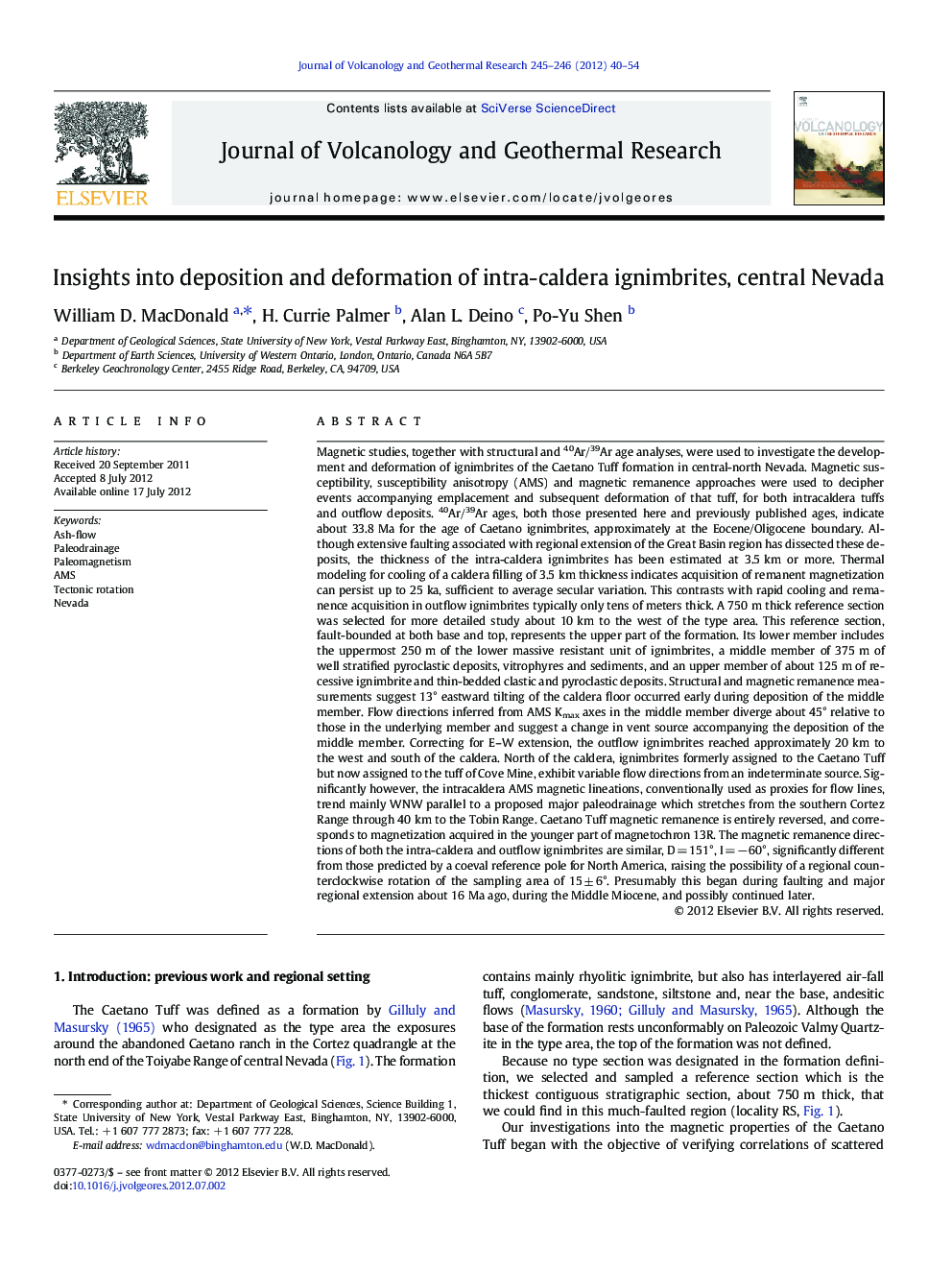| کد مقاله | کد نشریه | سال انتشار | مقاله انگلیسی | نسخه تمام متن |
|---|---|---|---|---|
| 4712570 | 1638374 | 2012 | 15 صفحه PDF | دانلود رایگان |

Magnetic studies, together with structural and 40Ar/39Ar age analyses, were used to investigate the development and deformation of ignimbrites of the Caetano Tuff formation in central-north Nevada. Magnetic susceptibility, susceptibility anisotropy (AMS) and magnetic remanence approaches were used to decipher events accompanying emplacement and subsequent deformation of that tuff, for both intracaldera tuffs and outflow deposits. 40Ar/39Ar ages, both those presented here and previously published ages, indicate about 33.8 Ma for the age of Caetano ignimbrites, approximately at the Eocene/Oligocene boundary. Although extensive faulting associated with regional extension of the Great Basin region has dissected these deposits, the thickness of the intra-caldera ignimbrites has been estimated at 3.5 km or more. Thermal modeling for cooling of a caldera filling of 3.5 km thickness indicates acquisition of remanent magnetization can persist up to 25 ka, sufficient to average secular variation. This contrasts with rapid cooling and remanence acquisition in outflow ignimbrites typically only tens of meters thick. A 750 m thick reference section was selected for more detailed study about 10 km to the west of the type area. This reference section, fault-bounded at both base and top, represents the upper part of the formation. Its lower member includes the uppermost 250 m of the lower massive resistant unit of ignimbrites, a middle member of 375 m of well stratified pyroclastic deposits, vitrophyres and sediments, and an upper member of about 125 m of recessive ignimbrite and thin-bedded clastic and pyroclastic deposits. Structural and magnetic remanence measurements suggest 13° eastward tilting of the caldera floor occurred early during deposition of the middle member. Flow directions inferred from AMS Kmax axes in the middle member diverge about 45° relative to those in the underlying member and suggest a change in vent source accompanying the deposition of the middle member. Correcting for E–W extension, the outflow ignimbrites reached approximately 20 km to the west and south of the caldera. North of the caldera, ignimbrites formerly assigned to the Caetano Tuff but now assigned to the tuff of Cove Mine, exhibit variable flow directions from an indeterminate source. Significantly however, the intracaldera AMS magnetic lineations, conventionally used as proxies for flow lines, trend mainly WNW parallel to a proposed major paleodrainage which stretches from the southern Cortez Range through 40 km to the Tobin Range. Caetano Tuff magnetic remanence is entirely reversed, and corresponds to magnetization acquired in the younger part of magnetochron 13R. The magnetic remanence directions of both the intra-caldera and outflow ignimbrites are similar, D = 151°, I = − 60°, significantly different from those predicted by a coeval reference pole for North America, raising the possibility of a regional counterclockwise rotation of the sampling area of 15 ± 6°. Presumably this began during faulting and major regional extension about 16 Ma ago, during the Middle Miocene, and possibly continued later.
► Caetano Tuff age placed in upper part of geochron 13R.
► Paleomagnetic evidence consistent with 15 ± 6° counterclockwise rotation since 16 Ma.
► AMS magnetofabric studies indicate flowlines parallel to large westward paleodrainage.
Journal: Journal of Volcanology and Geothermal Research - Volumes 245–246, 1 November 2012, Pages 40–54